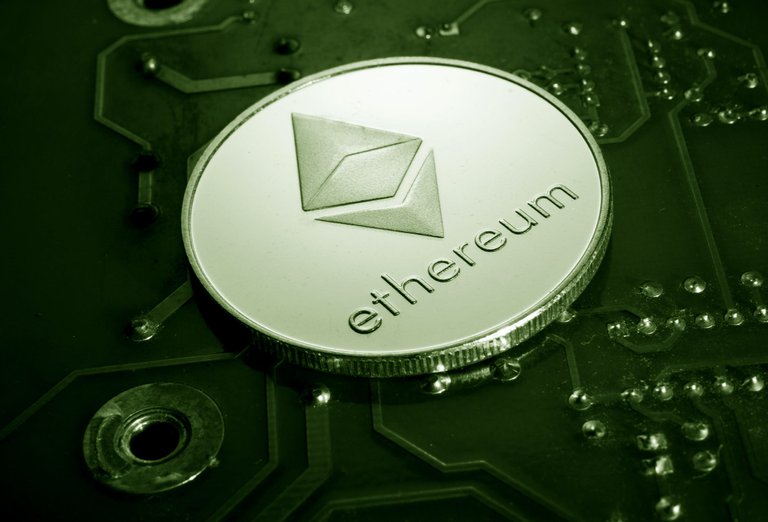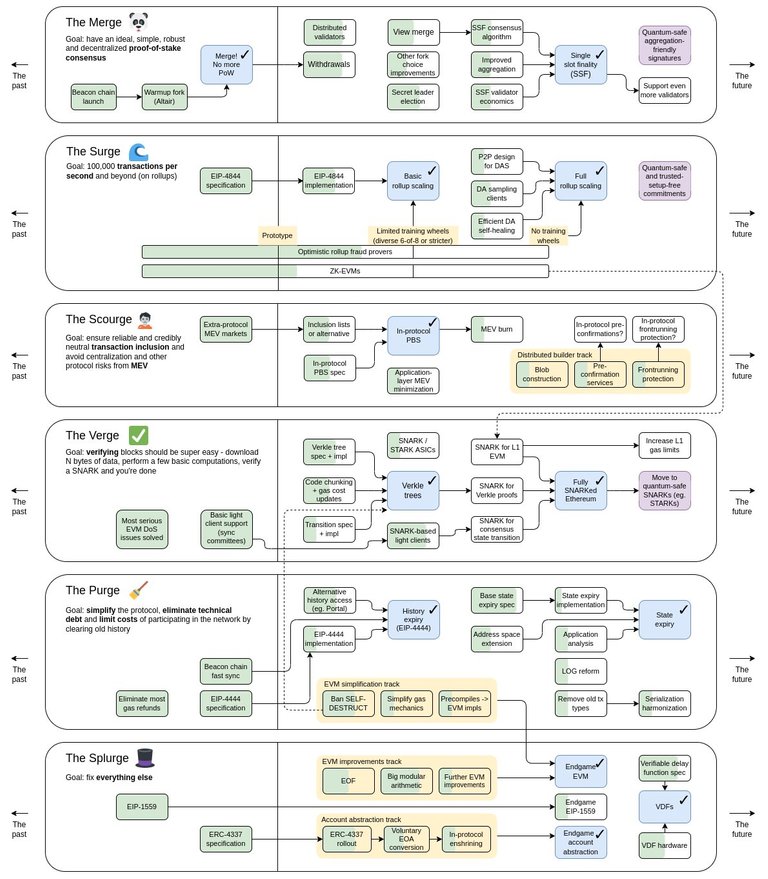
Ethereum is a blockchain-based software platform that enables developers to build and deploy decentralized applications using smart contracts and distributed applications.
Ethereum is a decentralized and open-source public service that uses blockchain technology to facilitate smart contracts and cryptocurrency trading securely without a third party or middleman. Quoted from BernardMarr
It is the second most popular blockchain next to Bitcoin.
Ethereum blockchain has a centralized block explorer called Etherscan where anyone can view all transactions, wallet address, balances and others.
ETH, the native token
Ether (ETH) is the native token of Ethereum network which is used to pay for activity on the Ethereum blockchain. Other assets built on the blockchain like ERC-20 tokens require ETH for transaction fees. The coin can be bought or traded on various centralized crypto exchanges (CEX) and decentralized exchanges (DEX).
Max Supply
ETH does not have a maximum supply but there is an annual limit and increases every year.
Per the initial presale in 2014, Ether capped its limit to 18 million per year which is 25% of Ethereum's initial supply and while the absolute issuance is fixed, relative inflation will be decreased every year. And according to simulations from Ethereum tracker Ultrasound Money, after the transition to proof of stake, the supply of ETH is set to decline 2% annually. Source
The limit is subject to change however as Ethereum's developers continue to make updates to the network. Additionally, Ethereum's supply increases every year, and there is no cap on its cryptocurrency.
As of 2nd May 2023, Ethereum has a circulating supply of 120,230,939 ETH coins.
Brief History of Ethereum
2013
Ethereum was developed by programmer Vitalik Buterin (co-founder of Bitcoin Magazine) who published a White Paper describing a way to build decentralized applications. Other founders of Ethereum included Gavin Wood, Charles Hoskinson, Anthony Di Iorio, and Joseph Lubin. The Ethereum blockchain was written in the Solidity programming language. Today, Ethereum has hundreds of developers involved in it.
2014
Development work began and was crowdfunded, raising 31,529 BTC, or roughly $18.4 million at then-market prices through the sale of Ether its native blockchain tokens. *(Coindesk)
2015
The first live release of Ethereum network known as Frontier happened on the 30th of July 2015.
Ethereum was initially described as a way to build decentralized applications that could attach real-world assets, such as stocks and property to the blockchain.
Ethereum has experienced and suffers from some challenges and issues similar to that of Bitcoin, primarily in its scalability.
2016
$50 million in Ether was stolen by an anonymous hacker which resulted in questions about the platform’s security. (Source)
The hack split the community and the Decentralized Autonomous Organization (DAO event occurred leading to a hard fork and the creation of Ethereum Classic which is based on the original protocol but managed by a separate team of developers..
2017
Ethereum experienced significant growth and transaction volumes, leading to extremely high fees for applications running on Ethereum network.
2022
Ethereum network successfully transitions from Proof of Work (PoW) to Proof of Stake (PoS) on the 15th of September 2022.
2023
Ethereum continues to evolve and change the cryptocurrency landscape with significant innovations.
Major upgrades in Ethereum network
Byzantium upgrade
This was a hard fork development that was implemented in October 2017 at block 4,370,000. It is the first and only one of many upgrades that formed part of the Ethereum Metropolis roadmap. Its goal was to improve the confidentiality, stability and resilience of the network.
The upgrade consisted of nine Ethereum Improvement Protocols (EIPs) designed to improve Ethereum's privacy, scalability, and security attributes. It was implemented to allow faster transactions and greater security on the Ethereum blockchain while making smart contracts suitable for business transactions.
The Byzantium upgrade was the fifth and a significant upgrade to Ethereum's blockchain.
Constantinople
This was primarily a maintenance and optimization upgrade that only affected miners, the specialized hardware operators who assemble Ethereum transactions into blocks and compete for network rewards. (Source)
The upgrade was released on the Ethereum [mainnet on the 28th of February 2019 at block number 7,280,000. It was combined with the St. Petersburg upgrade which was meant to delete a previous update, Ethereum Improvement Proposal (EIP) 1283, from the network. (Source)
Beacon Chain
This was the first upgrade on the Ethereum 2.0 which includes several phases and upgrades. The Beacon Chain upgrade went live on the 1st of December 2020.
EIP-1559
This is also called the London hard fork happened on the 5th of August 2021 at block 12,965,000. This was an Ethereum improvement proposal that both upped the block size to help combat congestion on the network and destroyed transaction fees rather than send them to miners. The aim was to put deflationary pressures to the asset that has a circulating supply that is 6 times larger than that of Bitcoin's. Apparently, there's already been a 57% reduction in ETH issuance where over 1.1 million ETH were distributed to miners as block rewards and nearly 630k ETH have been burned. - (Source)
The Merge
This is a major software upgrade to the Ethereum blockchain which is similar to how a smartphone or computer might upgrade to a new version. It transitions Ethereum from proof of work (PoW) to a proof-of-stake (PoS) consensus mechanism and was completed on the 15th of September 2022.
The switch to PoS has moved the entire blockchain over to new PoS validator nodes that require staking or locking up 32 Ether (ETH) to join.
The Merge has given birth to Ethereum 2.0, a new version of Ethereum that results in a 99.95% reduction in Ethereum's energy consumption and the ability to further scale the Ethereum ecosystem. This upgrade is expected to reduce the amount of energy needed to create new coins and carry out transactions.
It is not likely to reduce gas fees in the short-term however because the upgrade is about a change in the consensus mechanism, rather than an increase or expansion of its capacity.
The Merge was completed in a two-step process, which have been named the Bellatrix & Paris upgrades. During the Merge, users may not be able to transfer Ethereum-based assets.
Sources: Ethereum roadmap, Coindesk The Defiant
The Shanghai upgrade
This is also known as Shapella which happened in the 12th of April 2023 is the largest planned upgrade since the Merge and enables users to unlock their staked ether (ETH) which has been locked up since the “deposit contract” went live in 2020.
The Shanghai upgrade included the implementation of five different Ethereum Improvement Proposals (EIPs) that were intended to improve the transactional aspects of Ethereum. It was accompanied by the Capella upgrade, which applied changes to the Consensus Layer, hence the joint moniker “Shapella.”
This upgrade brought a record-breaking weekly inflow of ether (ETH) deposits for staking which is mainly driven by institutional staking service providers and investors reinvesting rewards after withdrawal.
The Bedrock upgrade
This is a major upgrade to the network that aims to decrease transaction fees and improve the functionality of the network by cutting deposit-confirmation times from 10 minutes to 1 minute and lowering gas fees by 40%. Simply put, its goal is to increase the speed of transactions, and enhance smoother compatibility with the Ethereum Virtual Machine (EVM). This was implemented by Optimism on the 6th of June 2023.
Expected or planned upgrades on Ethereum network

The Scourge
This is related to censorship resistance, decentralization, and protocol risks from MEV.
The Verge
This is a planned upgrade which is related to verifying blocks more easily.
The Purge
An upgrade related to reducing the computational costs of running nodes and simplifying the protocol.
The Splurge
This is a series of smaller upgrades aimed at ensuring that the Ethereum network runs smoothly following the above four major updates.
The Dencun upgrade
This will be the next major upgrade after the Shanghai upgrade, which will focus on scaling to reduce transaction costs. It is expected to happen on the second half of 2023.
Source: Ethereum Roadmap
Historical Price of Ether (ETH)
The price of ETH has fluctuated significantly since its launch in 2015 where 1 ETH was under a dollar, lowest at USD0.42, the highest exchange price was USD3.54
In 2016, ETH reached an ATH of USD21.52 for the year and the lowest being 92 cents. It closed the year at USD7.97
In 2017, ETH's price rose to USD881.94 (grew more than 13,000%) and the lowest price was USD7.98 then ended the year at USD756.73
By January 2018, ETH's price peaked at USD1,433 before falling sharply ending the year at USD133.
In 2019, ETH's highest price was USD365 and the lowest being USD102.
By the year 2020, highest price was USD753.
In 2021, the price soared to USD4,858.
It was USD3,883 in 2022 and the year closed at USD1,196.
As of June 4, 2023, ETH's price is at USD1,792.91
Source: CoinLore
Summary (TL;DR)
Ethereum is the second most popular network next to Bitcoin.
ETH, the blockchain's native currency has no max supply but has an annual limit of 18 million per year and increases accordingly.
ETC (Ethereum Classic) was born out of a DAO after the Ethereum network was hacked in 2016 which raised concerns over its security.
Ethereum has transitioned from PoW to PoS in 2022 which requires validators to stake 32 ETH to join.
There had been various upgrades and or hard forks in the Ethereum network with the aim of improving it. Other planned upgrades are yet to happen.
Price of ETH is volatile and fluctuated from since its launch in 2015.

For infotainment only. Sources of images and info have been cited accordingly. 08062023/20:20ph
Posted Using LeoFinance Alpha
Congratulations @ifarmgirl-leo! You have completed the following achievement on the Hive blockchain And have been rewarded with New badge(s)
<table><tr><td><img src="https://images.hive.blog/60x70/http://hivebuzz.me/@ifarmgirl-leo/comments.png?202306090424" /><td>You made more than 17000 comments.<br />Your next target is to reach 18000 comments. <p dir="auto"><sub><em>You can view your badges on <a href="https://hivebuzz.me/@ifarmgirl-leo" target="_blank" rel="noreferrer noopener" title="This link will take you away from hive.blog" class="external_link">your board and compare yourself to others in the <a href="https://hivebuzz.me/ranking" target="_blank" rel="noreferrer noopener" title="This link will take you away from hive.blog" class="external_link">Ranking<br /> <sub><em>If you no longer want to receive notifications, reply to this comment with the word <code>STOP <p dir="auto">To support your work, I also upvoted your post! <p dir="auto"><strong>Check out our last posts: <table><tr><td><a href="/hive-122221/@hivebuzz/pum-202305-delegations"><img src="https://images.hive.blog/64x128/https://i.imgur.com/fg8QnBc.png" /><td><a href="/hive-122221/@hivebuzz/pum-202305-delegations">Our Hive Power Delegations to the May PUM Winners